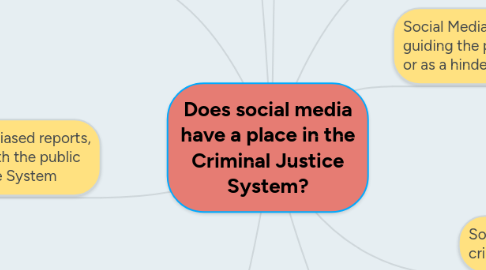
1. Social Media is a vast tool of communication within the Criminal Justice System
1.1. Police have a whole new level of access to the public and vice versa, the public have a whole new level of access to the police
1.2. The people in the public are able to contact the police via social media to report incidents and suspicious behavior faster the filing a report.
1.3. Social Media is a tool that allows the police to reach the younger population in today's society as well as the older generation
1.4. Social Media allows the police to get the information out in a faster way that already has the public's attention and is broadly used among all citizens
2. Social Media is a newer and faster way get the lastest news and updates of investigations and criminal proceedings
2.1. The public now have access to news reports and articles via social media almost instantly compared to yesterday's news in the daily paper
2.2. As a member of the public you no longer have to wait for a news on the television or a radio announcement to be made as social media updates regularly
2.3. Police can use social media to reach out to specific people as well as public announcements and alerts much faster then other tools
3. Social Media can lead to biased reports, feelings and actions in both the public and in the Criminal Justice System
3.1. Social Media present many new ways and opportunities to solve crime with in the Justice System
3.1.1. Valuable footage can be retrieved through social media such as security or CCTV film
3.1.2. Social media can aid the police in tracking a victim or a possible suspect by using their social media account to piece together their activities throughout the day
3.1.2.1. This can help with the whereabouts as well as their activities
3.1.3. Social media accounts can be used in the identification of a victim or suspect through their online profiles and picture data bases
4. Social Media is not fact checked and therefore is not always accurate
4.1. Social Media is foremost a social network where anyone from anywhere can have an opinion and share their opinions
4.1.1. It is not always the truth and is not always accurate
4.1.2. Even though the facts are not true their power to influence the public and play a part in important public decision does not change
4.1.2.1. This means many decisions put down to a public vote can and are heavily influence by these facts since they have not been indentified as false
5. Social Media can be used to gain evidence, receive evidence and help support evidence
5.1. When a story is released on social media it may not be from a valid source meaning not all the facts and events are accurate
5.1.1. This can lead to a biased public opinion
5.1.2. It may cause a biased opinion in the jury meaning the convicted may or may not receive a fair trial
6. Social Media can lead to Victimisation
6.1. Families and friends of the convicted become the victim to hate crimes, harsh comments/statements and violent threats
6.1.1. This can be done through their social media accounts as well as physically due to the amount of personal details stored on social media such as email, addresses and phone numbers
6.2. 'Victim blaming' within the public can occur
6.2.1. "they got what they deserved" and so on...
7. Social Media can be used to commit crimes
7.1. Social Media allows offenders a whole new level of contact that can aid in Blackmail
7.2. Privacy leaks and settings through social media can lead to identity theft and/or credit card fraud
8. The nature of the crime can change when affected by Social Media input
8.1. Social Media can be turned into a bragging platform for petty crime such as vandalism and theift
8.1.1. If a criminal is getting attention for the wrong reason it may fuel their ego leading to bigger and more dangerous crimes
